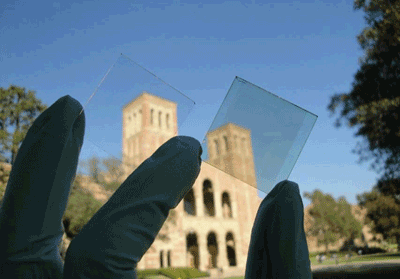Transparent solar cells for windows generate electricity
Windows will have the ability to generate power while still allowing outdoor visibility
Researchers out of UCLA have developed an affordable-to-produce transparent solar cell that can be applied to windows, giving them the ability to generate electricity while still allowing people to see outside.

Researchers have successfully demonstrated visibly transparent polymer solar cells.
In their report, the team describes their new form of polymer solar cell, one that produces energy by absorbing mostly infrared light, not visible light. This allows the cell to be nearly 70% transparent to the human eye.
The polymer solar cell
The project is the result of a multi-department collaboration: the researchers involved came from the California NanoSystems Institute, the UCLA Henry Samueli School of Engineering and Applied Sciences, and UCLA’s Department of Chemistry and Biochemistry.
The technology they developed is a high-performance, solution-processed, visibly transparent polymer solar cell. It incorporates near-infrared light-sensitive polymer and uses silver nanowire composite films as the top transparent electrode.
The polymer absorbs near-infrared light and is less sensitive to visible light; this, in turn, balances the cell’s performance and transparency in the visible wavelength region.
A transparent conductor
Not to be lost behind the headlining transparent polymer solar cell is the other breakthrough in this story: a transparent conductor. It’s made of a mixture of silver nanowire and titanium dioxide nanoparticles, which together replace the opaque metal electrode typically used with these technologies.
The composite electrode allows solar cells to be fabricated economically, vis-à-vis solution processing. With this unique combination of two breakthroughs in one study, power-conversion efficiency for solution-processed and visibly transparent polymer solar cells has been achieved.
“We are excited by this new invention on transparent solar cells, which applied our recent advances in transparent conducting windows (also published in ACS Nano) to fabricate these devices,” said Paul S.Weiss, CNSI director and Fred Kavli Chair in NanoSystems Sciences.
Outlook
Study lead Yang Yang, a UCLA professor of materials science and engineering and the director of the Nano Renewable Energy Center at California NanoSystems Institute, describes the possibilities available for the new technology: “These results open the potential for visibly transparent polymer solar cells as add-on components of portable electronics, smart windows and building-integrated photovoltaics and in other applications.”
He adds that there’s already significant interest in their polymer solar cells, saying “Our new PSCs are made from plastic-like materials and are lightweight and flexible.” He adds, “More importantly, they can be produced in high volume at low cost.”
Overall, engineers and scientists alike are very interested in furthering the development of polymer solar cells, as they have significant cost and performance advantages over competing solar cell technologies. Additionally, they offer tremendous potential in advancing the technology to broader applications, including building-integrated photovoltaics as well as photovoltaic chargers for portable electronics.
The technology still has a bit of a way to go, as it is less efficient than commercial solar products available now: It converts approximately 4% of the sun’s energy into electricity. Yang said his team has tested films that yielded as much as 11%, and that they aim to push higher. ■
The study is available via: ACS Nano
Story via: ucla.edu
Advertisement
Learn more about Electronic Products Magazine





